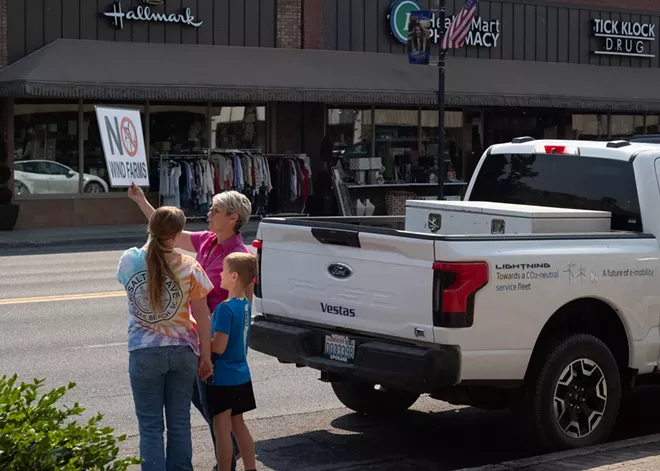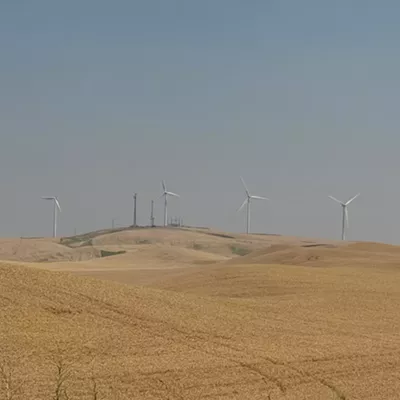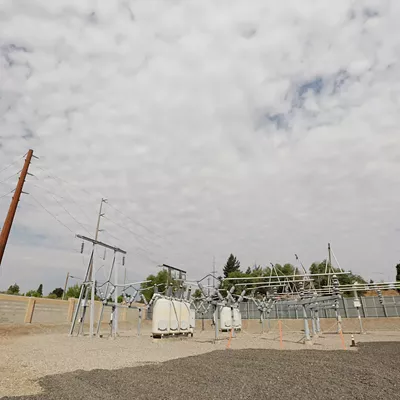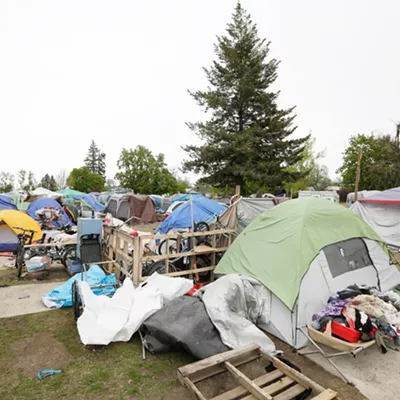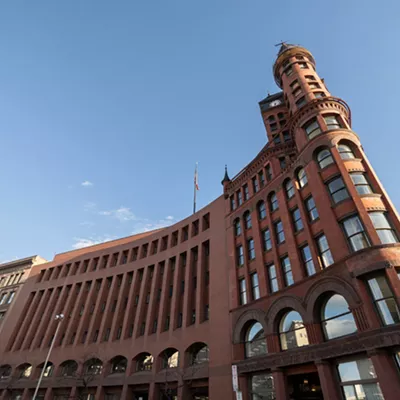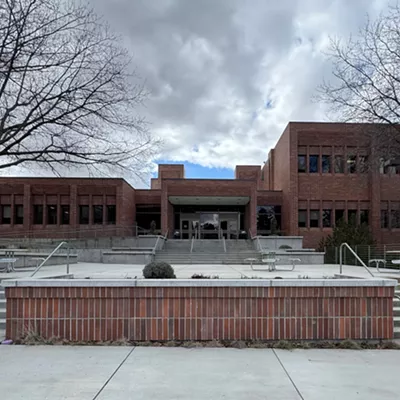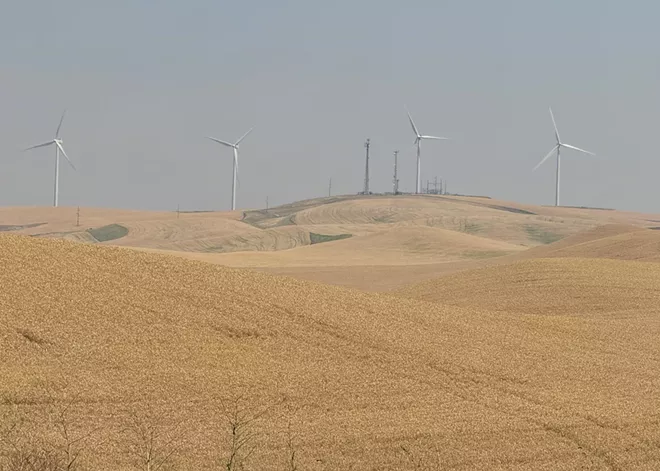
Whitman county could soon be home to 45 new wind turbines as part of the "Harvest Hills wind project," a proposal to install renewable energy wind turbines near Kamiak Butte and generate hundred of megawatts of clean power. The project is being led by Steelhead Americas, the North American branch of Vestas, a Danish company that's the world's largest wind turbine producer. Officials say the project will bring massive benefits to the region — but some locals are unconvinced.
As the project moves forward, several local groups have sprung up in opposition. Many residents are upset about the project's potential impact on the region. They say it would be an eyesore for those who regard the Palouse region as a picturesque destination and argue the potential positive impacts are not enough to justify the change.
Shane Roche, the project developer for the Harvest Hills Wind Project, disagrees. The wind turbines will bring in tens of millions of dollars in tax revenue and create hundreds of new construction jobs, he says. The wind turbines will "preserve family farms by helping our farmers keep farms within their families," Roche adds.
The proposal will be submitted to Whitman County for approval in early 2025. Before being submitted to the county, the project must conduct impact studies, develop design proposals, and meet local and state codes.
BLOWING IN THE WIND
When wind flows through a turbine, it creates lift and drag, causing the rotor blades to spin. The rotor blades connect to a gearbox that cranks a generator, producing energy. The energy is then transferred through transmission lines that eventually find their way to homes and businesses.The technology is similar to hydropower, which utilizes rotors to turn the kinetic energy into the same energy that powers homes, Roche says.
The proposed turbines require about an acre of leased land per turbine and are expected to be built between the cities of Colfax and Palouse. Officials with Steelhead Americas have leased land from some local landowners.
The turbines proposed for Harvest Hills will be taller than those of other projects, such as the Palouse Winds Project, which was built about a decade earlier in Whitman County. Technological advances are a big reason behind the height increase.
"The turbines that we're planning on installing in Harvest Hills," Roche says, "create three times the amount of electricity than projects that were built 10 years ago, on the same amount of land."
Specifically, he says the 45 turbines will produce 200 megawatts of clean power or enough energy to power 900,000 homes, as well as create 250 construction jobs and 30 long-term jobs.
If the permits are approved by the county in early 2025, the project can begin construction in 2026 and remain active for 30 years. If it's not approved, however, Steelhead Americas can go through a state-level approval process.
As America moves away from fossil fuels, energy needs are expected to increase dramatically. Washington's Clean Energy Transformation Act aims to eliminate electric utilities that cause greenhouse gas emissions by 2045. At the federal level, President Joe Biden's Inflation Reduction Act is incentivizing renewable energy manufacturing and production in rural areas through solar and wind power.
U.S. Rep. Cathy McMorris Rodgers, whose district covers Whitman County, chairs the House Energy and Commerce Committee. She has stressed the massive amount of energy that will be needed to support artificial intelligence. She voted against the Inflation Reduction Act, and has pushed for nuclear and hydropower energy production as a way to meet electrical demands.
BLOWBACK
Some Whitman County residents say they support the idea of renewable energy but think it would be better located along coastlines instead of in their backyards.A Facebook group titled "Stop Kamiak Butte Industrial Wind Project" has more than 1,800 members and a change.org "Protect Kamiak Butte: Stop the Harvest Hills Wind Project!" petition has more than 2,200 signatures of support.
Whitman County resident Dan Lenssen is leading the Facebook group and working to bring awareness to the project. He's lived and worked in the region for almost 17 years and is concerned that properties around him have signed up for the lease. He's in the middle of two potential turbine sites.
Lenssen first found out about the project in January after the first meteorological evaluation towers went up. Shortly after, two more were put up north and west of Kamiak Butte, he says. Some of his concerns about the project are shadow flickers, noise issues and red strobe flashing. His biggest concern is the potential fire hazards to the area.
"Everything likes to burn now for wildfires, and these things are known to get struck by lightning and start a fire and or just [from] poor maintenance," Lenssen says. "They start on fire quite often."
Lenssen quickly pointed to a turbine fire at Palouse Winds that happened in 2017 and how challenging it would be for rural fire departments to extinguish or mitigate such fires. Because the fires are 400 feet in the air, it's difficult to control them, and fire departments have to wait until the turbine burns out.
Roche, the technician, says the technology behind wind turbines has drastically improved and reduces the risk of fires.
"There are fire prevention systems within the turbine, and if there are any errors, the turbine shuts down," Roche says. "It's very rare that a turbine will have a fire, but we'll let it burn, make sure we work with the community and emergency management systems to ... make sure that there's no spread."
Lenssen says the potential for wildfires is just not worth the price of the beautiful region he calls home. There is no tradeoff worth it for him, he says.
"This is the Tuscany of America just for its extremely unique landscape feature, and not to mention it's some of the best farmland in the world with its production of crops," Lenssen says. "At some point you're gonna have some pushback, and I think this is the time when you need to push back."
'VISUAL IMPACT'
On July 26, residents gathered at the Whitman County Library in Colfax for an informational meeting put on by Vestas and Steelhead Americas. Many residents had concerns, but some seemed excited. One 10-year-old boy wore a wind turbine T-shirt and enthusiastically peppered the wind technicians with questions.Vestas wind technician Dan Kolve answered questions about his work and the jobs the project will create. Kolve lives in Spokane County with his wife and three daughters. After years of working as a traveling wind turbine technician, his Vestas job allows him to remain in the area to maintain the wind turbine farm 10 miles from Oakesdale, just off Highway 195, he says.
Bob Johnson, a Moscow resident, was concerned the wind turbines would have a visual impact on Kamiak Butte Park. He attended the informational viewing session and was open-minded about the need for renewable energy sources. Johnson has solar panels on his home. He said he still wants the project to be studied carefully, but felt that some of his concerns were addressed.
"It looks like the visual impact from Kamiak Butte is not very significant, and I like to hike there, and that's why I was concerned," Johnson says. "I think it's a lesser issue than addressing climate change."
Many residents showed up to protest the event outside the library. They held signs and expressed their frustration with the project at the meeting. Bonnie Brumley is a member of the Save the Palouse organization and a farmer in the area. She's worried the turbines will permanently destroy the farmland.
"They will say that if they take the turbine down, they'll cover it with 18-inches of soil — that's nothing, that's not farmable," Brumley said.
Roche said impact studies will be done to mitigate potential harms; officials will also do avian studies to see if the turbines will impact wildlife.
The waste from wind turbines was a concern for many residents. Once the project comes to an end after three decades of use, the materials are difficult to recycle because they're designed to be light and durable in harsh conditions at the end of the turbines' lifecycle.
However, according to Roche, 85% of turbines are recyclable, and Vestas is a leader in blade recycling. The company's goal is to create fully recyclable blades by 2030 and to produce zero waste by 2040.
Roche says the Whitman County code requires wind turbines to be kept a certain distance from non-participating landowners. He also addressed concerns from residents who worried about the visual impact of the red blinking lights turbines used to prevent collisions with aircraft.
"What this system does is it keeps the lights off at night unless there's a plane that's approaching," Roche says, "If you have a plane fly within 3 miles and below 3,000 feet, it will turn the lights on because they are required by the FAA."
COMMUNITY FUNDING
The Harvest Hills Wind project is not the region's first. The Palouse Wind turbine project, located between Steptoe Butte and Rosalia along Highway 195 has been active for about a decade.According to financial data from Whitman County Assessor Wraylee Flodin, the county has collected between $800,000 and $1.1 million dollars in property tax revenue per year since 2014.
Those funds have been used for county services that include veterans relief, libraries, schools districts, state schools, emergency medical services, fire districts, cemetery districts, fire districts, parks and recreation services, schools, and many more services.
"The millage rate, or the total of all levies by district, changes from year to year based on the budgetary needs of each taxing district," Flodin says.
According to Whitman County Planner Alan Thomson, Steelhead Americas hasn't submitted a permit application yet, but expects to see one at the beginning of 2025. The review process will take several months to review all the details.
"Ultimately, the decision goes to our hearing examiner, but we will have a thorough investigation of all the potential impacts for several months," Thomson says, "probably starting at the beginning of next year, and see where that goes." ♦

